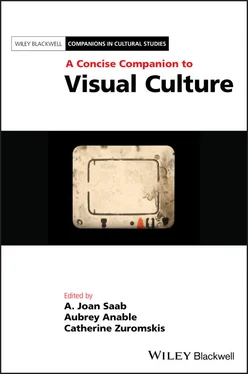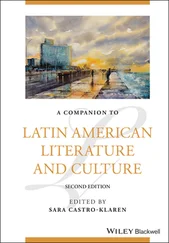1 ...7 8 9 11 12 13 ...36 Our first draft of Practices of Looking was suggestive and open‐ended, leaving many ways of doing interpretation up to the reader and doing so by design. This approach did not sit very well with some of the first press reviewers, who felt that we needed to interpret the images with more specificity, provide more textual analysis—in order to make the book, in effect, more of an instructional, how‐to‐read‐images teaching book. Although we decided to go with Oxford University Press, its New York office was not interested in the book. The first edition was published by the UK office of the press and was aimed in part at the British context of art school and emerging visual culture programs. Later, after the book did particularly well in the United States, the New York office took over our contract for the second edition and classified the book as a textbook. It had not been written with this intention.
When Practices of Looking was first published, we were surprised at the extent to which it had a life of its own. It was taught in many different kinds of classrooms, more broadly than we had imagined. The timing of the publication was serendipitous: the book coincided with trends in pedagogy that suggested the field of visual culture was emerging in several disciplines at once, and not simply in innovative and forward‐thinking art history departments. Communication departments, history and literature departments, and critical theory programs in art schools were using the book. Whereas we, as we have noted, were trained in the humanities, we both landed in communication departments early on in our careers. Thus we had found it necessary to explain our interests and our research and teaching methods often, not only to students but also to peers and supervisors. Why consider art in the context of communication studies? How was visual culture pertinent outside popular media cultures? The dynamic was reciprocal. As we become more entrenched in communication studies, we imported the field’s methods, histories, and interests into the second and third editions of the book. It may be said they were already present in the first edition’s media and advertising chapters, of course, but these became more integral to the book’s scope and structure in the subsequent editions.
The unexpected popularity of Practices of Looking as a teaching book resulted in unexpected outcomes for us as co‐authors. The most obvious of these was the demand that the book be updated, a requirement that came of course from our publisher. Academic writers are all too familiar with the demand placed by publishing houses on authors of textbooks to revise their books so that students must acquire a new edition rather than cheaper, used copies of an earlier edition. We were reticent to comply. When we wrote the first edition, we had naively assumed that we would write one book, and that it might continue to have relevance (as Ways of Seeing had done). But we began to see that the book was becoming outdated in a relatively short period of time. The world of image production and consumption had changed significantly, and the theoretical concepts necessary to make sense of images, visuality, the changing worlds of the Internet, image circulation, and social media, and the politics and dynamics of global media production had been transformed. Global and local political uprisings and social movements needed to be addressed, as did important shifts in scholarship and practice around colonial and postcolonial modernity and globalism. Thus we were compelled to rewrite almost three quarters of the book for its second edition, and nearly as much for the third. The process has thus been a kind of taking stock in eight‐year increments, even though the structure and many of the basic theories remain in place. An example will help to demonstrate this point. In the first edition we wrote about Foucault on both biopower, and the internalization of discipline and surveillance. We cited the now familiar examples of exercise culture and body image and the panopticon. By the third edition, these concepts were adapted to discussing body‐tracking devices such as the FitBit and surveillance in militarized global information systems in political countermovements.
For the second edition, which was released in 2008, some of the revision was driven by changes in technology such as the emergence of the web as a platform for images, entertainment media, and commerce. The rise of Google, the emergence of YouTube (which began as an amateur video‐sharing site in 2005), and the increase of broadband, which enabled changing trends in the digital global circulation of images, all needed to be accounted for. It is amusing to note that, in our concern not to have the second edition date too quickly, we discussed whether to include YouTube, wondering whether it would last or fade quickly, as other Internet startups had. Even more urgently, we needed to address visual culture in the post‐9/11 world, in which images played a powerful role in the experience and memorialization not only of 9/11 but also of events such as the Iraq War, or Abu Ghraib prison culture: there the media did not simply document but served as a key factor in the staging of conflict and the enactment of abuse. Shifts in cultural trends also needed to be addressed as we reworked the book – the increasing global circulation of television formats and film genres, for example, the emergence of animation as a key genre of ironic and critical modes of cultural expression, and video gaming as a major form of cultural production and distribution.
Our eventual work on a third edition of the book, released in 2018, challenged us to see how dramatically certain aspects of visual culture had been transformed yet again, in particular in relation to practices of surveillance and to the emergence of a culture in which the consumer’s cultural production—the taking of pictures—had become fully ubiquitous, undoing the binary of consumption and production that had informed the Frankfurt School model, which had been dominant in the late twentieth century. In the 2010s the smartphone, first introduced in 2007, became the primary device for everyday image culture, transforming how, when, and of what people take pictures. Social media and Facebook (founded in 2004), increasingly designed to support still images and video, and Instagram (introduced in 2010 and bought by Facebook in 2012), had sprung up as key sites for sharing images in a market increasing shared by TikTok (founded in 2012). These corporate entities changed the role of images in networks and in the creation of social connection (hence the birth of the selfie). At the same time, image stockpiling and brokering had become high‐stakes big business. And, inexplicably, in the wake of the 2008 economic collapse, the art market appeared as an investment option of choice among the “one percent”; thus its elite global art fair and museum culture ascended in tandem with the media, the image, and information‐savvy cultures of movements such as Occupy, the Arab Spring, and Black Lives Matter. We marveled at YouTube’s cultural dominance and at the platform’s success in spawning new genres of its own. This culture of ubiquitous non‐professional image production gave rise to citizen journalism, a phenomenon that continues to undermine the careers of professional journalists but that has made possible witness documentation of police violence and murder of black and brown peoples in the United States, where the Black Lives Matter movement has used witness documentation as a media and legal tool while also raising important concerns about the politics of image‐sharing strategies. Yet the consumer as producer and witness has also shown us the limits and contingencies of “visual power”: such images have thus far failed to secure justice for the victims of police violence, in spite of the recognition that they constitute clear evidence of these acts. In our work on the second edition, and even more so on the third, we aimed to shift the scope of the book so as not only to address the global circulation of images and the global flow of culture, but also to deprovincialize the canon, to move away from its Euro‐American‐centric focus, and to include more work by women artists and artists of color, and to emphasize artists who work on political issues through research‐based practice. This shift entailed, in part, reworking theories of modernity to better account for the literature on postcolonial and settler histories and, in part, tracking new research into image cultures in the movement politics of the 2010s.
Читать дальше












